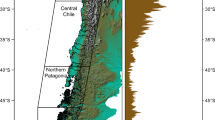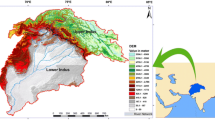Abstract
The present study evaluates the performance of Coupled Model Intercomparison Phase 6 (CMIP6) of three global climate models for spatiotemporal projections of temperature and precipitation over Afghanistan. Climate patterns were analyzed for two future time slices, i.e., mid-century (2030–2059) and late century (2070–2099) with reference to historical periods (1985–2014). Three CMIP6 models (i.e., CNRM-CM6-1, EC-Earth3-CC, MRI-ESM2-0) and their ensemble under shared socioeconomic pathways (SSP) 2–4.5 and 5–8.5 scenarios are implemented. The results of the temporal analysis indicate that mean daily rainfall of mid-century and late century will increase by 3%, and 8% under SSP2-4.5 and 4%, and 15% under SSP5-8.5 scenarios, respectively. Similarly, the mean daily temperature of mid-century and late century is projected to increase by 13% and 22% under SSP2-4.5 and 17%, and 41% under SSP5-8.5 scenarios, respectively. The extreme rainfalls (95th percentile of cumulative distribution fuction) increase by 9–15% and 4–8% in the long-term and short-term future, respectively, which implies increasing flood frequency. In spatial analysis, each model indicated different precipitation trend. It is highly likely that the country’s northeast will experience an increase in precipitation, whereas the southern region will witness a decrease. The temperature of all three models suggest increasing trend throughout the country with greater changes over the late-century period under SSP5-8.5. The findings of this study provide detailed insights into the performance of CMIP6 models over Afghanistan and may serve as useful guidance for any policymaking regarding climate change in different regions of the country.







Similar content being viewed by others
References
Adib MNM, Rowshon MK, Mojid MA, Habibu I (2020) Projected streamflow in the Kurau river basin of Western Malaysia under future climate scenarios. Sci Rep 10:1–15. https://doi.org/10.1038/s41598-020-65114-w
Almazroui M, Saeed F, Saeed S et al (2020a) Projected change in temperature and precipitation over Africa from CMIP6. Earth Syst Env 4:455–475
Almazroui M, Saeed S, Saeed F et al (2020b) Projections of precipitation and temperature over the South Asian countries in CMIP6. Earth Syst Env 4:297–320
Almazroui M, Islam MN, Saeed F et al (2021) Projected changes in temperature and precipitation over the United States, Central America, and the Caribbean in CMIP6 GCMs. Earth Syst Env 5:1–24
Babaousmail H, Hou R, Ayugi B et al (2021) Evaluation of the performance of CMIP6 models in reproducing rainfall patterns over North Africa. Atmosphere 12:475
Chen Z, Zhou T, Zhang L et al (2020) Global land monsoon precipitation changes in CMIP6 projections. Geophys Res Lett 47:e2019GL086902
Craig A, Valcke S, Coquart L (2017) Development and performance of a new version of the OASIS coupler, OASIS3-MCT\_3. 0. Geosci Model Dev 10:3297–3308
Decharme B, Delire C, Minvielle M et al (2019) Recent changes in the ISBA-CTRIP land surface system for use in the CNRM-CM6 climate model and in global off-line hydrological applications. J Adv Model Earth Syst 11:1207–1252
Dissanayaka KDCR, Rajapakse RLHL (2019) Long-term precipitation trends and climate extremes in the Kelani River basin, Sri Lanka, and their impact on streamflow variability under climate change. Paddy Water Environ. https://doi.org/10.1007/s10333-019-00721-6
Döscher R, Acosta M, Alessandri A et al (2021) The EC-Earth3 earth system model for the climate model intercomparison project 6. Geosci Model Dev Discuss 2021:1–90. https://doi.org/10.5194/gmd-2020-446
Eyring V, Bony S, Meehl GA et al (2016) Overview of the Coupled Model Intercomparison Project Phase 6 (CMIP6) experimental design and organization. Geosci Model Dev 9:1937–1958. https://doi.org/10.5194/gmd-9-1937-2016
Gunathilake MB, Amaratunga YV, Perera A et al (2020) Evaluation of future climate and potential impact on streamflow in the upper nan river basin of Northern Thailand. Adv Meteorol. https://doi.org/10.1155/2020/8881118
Hamed MM, Nashwan MS, Shahid S et al (2022) Inconsistency in historical simulations and future projections of temperature and rainfall: a comparison of CMIP5 and CMIP6 models over Southeast Asia. Atmos Res 265:105927
Hamed MM, Nashwan MS, Shahid S (2021) Inter-comparison of historical simulation and future projections of rainfall and temperature by CMIP5 and CMIP6 GCMs over Egypt. Int J Climatol, 1–32. https://doi.org/10.1002/joc.7468
Huang J, Ji M, Xie Y et al (2015) Global semi-arid climate change over last 60 years. Clim Dyn 46:1131–1150. https://doi.org/10.1007/S00382-015-2636-8
International Federation of Red Cross and Red Crescent Societies (2020) Emergency plan of action operation update Afghanistan: drought and flash floods. In: International Federation of Red Cross and Red Crescent Societies: Geneva, Switzerland, Available online: https://www.ifrc.org
Kashifi MT, Mansoor U, Rahman SM (2022) Transit leverage assessment and climate change mitigation pathway for urbanised areas. Int J Glob Warm 26:18–37
Madec G, Bourdallé-Badie R, Bouttier P-A et al (2017) NEMO ocean engine. Zenodo. https://doi.org/10.5281/zenodo.3248739
Mahmood R, Jia S, Babel M (2016) Potential impacts of climate change on water resources in the Kunhar river basin. Pak Water 8:23. https://doi.org/10.3390/w8010023
Massar M, Reza I, Rahman SM et al (2021) Impacts of autonomous vehicles on greenhouse gas emissions—positive or negative? Int J Env Res Public Health 18:5567
Mehrad AT (2020) Assessment of climate change impacts on environmental sustainability in Afghanistan. In: E3S Web of Conferences
O’Neill BC, Tebaldi C, Van Vuuren DP et al (2016) The scenario model intercomparison project (ScenarioMIP) for CMIP6. Geosci Model Dev 9:3461–3482. https://doi.org/10.5194/gmd-9-3461-2016
Onyutha C, Asiimwe A, Ayugi B et al (2021) Observed and future precipitation and evapotranspiration in water management zones of uganda: Cmip6 projections. Atmosphere 12:887
Oshima N, Yukimoto S, Deushi M et al (2020) Global and Arctic effective radiative forcing of anthropogenic gases and aerosols in MRI-ESM2.0. Prog Earth Planet Sci 7:1–21
Roehrig R, Beau I, Saint-Martin D et al (2020) The CNRM global atmosphere model ARPEGE-Climat 6.3: description and evaluation. J Adv Model Earth Syst 12:e2020MS002075
Savage M, Dougherty B, Hamza M et al (2009) Socio-economic impacts of climate change in Afghanistan a report to the department for international development. In: A report to the department for international development; Stockholm Environment Institute: Oxford, UK, 2009
Sharma S, Hamal K, Khadka N et al (2021) Projected drought conditions over southern slope of the central Himalaya using CMIP6 models. Earth Syst Env 5:849–859
Shiru MS, Chung E-S (2021) Performance evaluation of CMIP6 global climate models for selecting models for climate projection over Nigeria. Theor Appl Climatol 146:599–615
Shrestha B, Babel MS, Maskey S et al (2013) Impact of climate change on sediment yield in the Mekong River basin: a case study of the Nam Ou basin, Lao PDR. Hydrol Earth Syst Sci 17:1–20. https://doi.org/10.5194/hess-17-1-2013
Shrestha S, Bajracharya AR, Babel MS (2016) Assessment of risks due to climate change for the Upper Tamakoshi Hydropower Project in Nepal. Clim Risk Manag 14:27–41
Stocker T, Dahe Q, Plattner G et al (2010) IPCC expert meeting on assessing and combining multi model climate projections. In: National Center for Atmospheric Research
Teutschbein C, Seibert J (2012) Bias correction of regional climate model simulations for hydrological climate-change impact studies: review and evaluation of different methods. J Hydrol 456–457:12–29. https://doi.org/10.1016/j.jhydrol.2012.05.052
Voldoire A, Saint-Martin D, Sénési S et al (2019) Evaluation of CMIP6 deck experiments with CNRM-CM6-1. J Adv Model Earth Syst 11:2177–2213
Wang B, Jin C, Liu J (2020) Understanding future change of global monsoons projected by CMIP6 models. J Clim 33:6471–6489
World Bank Group, Asian Development Bank (2021) Afghanistan climate risk country profile. In: Climate risk country profiles, Mandaluyong City 1550, Metro Manila, Philippines, pp 1–32
Yue Y, Yan D, Yue Q et al (2021) Future changes in precipitation and temperature over the Yangtze River Basin in China based on CMIP6 GCMs. Atmos Res 264:105828
Yukimoto S, Kawai H, Koshiro T et al (2019) The meteorological research institute earth system model version 2.0, MRI-ESM2.0: description and basic evaluation of the physical component. J Meteorol Soc Jpn Ser II 2019:2
Zhou Y, Xu YJ, Xiao W et al (2017) Climate change impacts on flow and suspended sediment yield in headwaters of high-latitude regions—a case study in China’s far Northeast. Water (switzerl). https://doi.org/10.3390/w9120966
Funding
This research did not receive any specific grant from funding agencies in the public, commercial, or not-for-profit sectors.
Author information
Authors and Affiliations
Corresponding author
Ethics declarations
Conflict of interest
The authors declare that they have no conflict of interest.
Additional information
Publisher's Note
Springer Nature remains neutral with regard to jurisdictional claims in published maps and institutional affiliations.
Rights and permissions
About this article
Cite this article
Farhat, F., Kashifi, M.T., Jamal, A. et al. Spatiotemporal projections of precipitation and temperature over Afghanistan based on CMIP6 global climate models. Model. Earth Syst. Environ. 8, 4229–4242 (2022). https://doi.org/10.1007/s40808-022-01361-2
Received:
Accepted:
Published:
Issue Date:
DOI: https://doi.org/10.1007/s40808-022-01361-2




